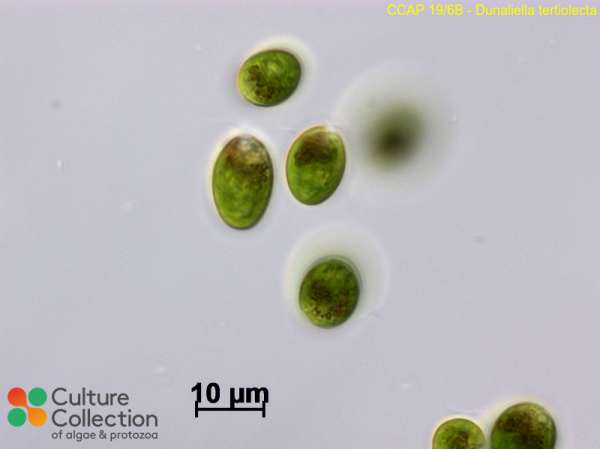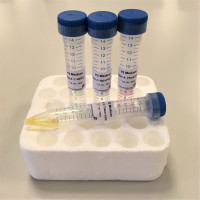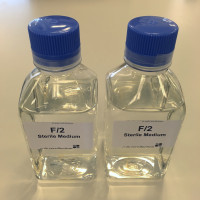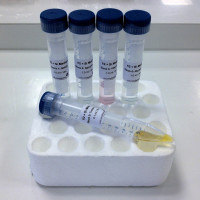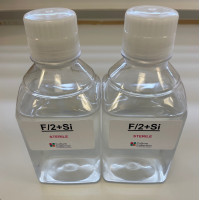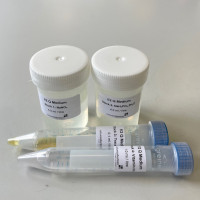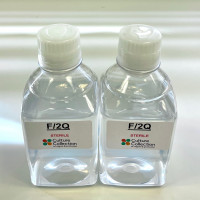References [ 37 ]
Marques A, Dinh T, Ioakeimidis C, Huys G, Swings J, Verstraete W, Dhont J, Sorgeloos P & Bossier P (2005) Effects of bacteria on Artemia franciscana cultured in different gnotobiotic environments. Applied and Environmental Microbiology 71: 4307-4317.
Segovia M & Berges JA (2005) Effects of inhibitors of protein synthesis and DNA replication on the induction of proteolytic activities, caspase-like activities and cell death in the unicellular chlorophyte Dunaliella tertiolecta. European Journal of Phycology 40: 21-30.
Marques A, Dhont J, Sorgeloos P & Bossier P (2004) Evaluation of different yeast cell wall mutants and microalgae strains as feed for gnotobiotically grown brine shrimp Artemia franciscana. Journal of Experimental Marine Biology and Ecology. 312: 115-136.
Segovia M, Haramaty L, Berges JA & Falkowski PG (2003) Cell death in the unicellular Chlorophyte Dunaliella tertiolecta. A hypothesis on the evolution of apoptosis in higher plants and metazoans. Plant Physiology 132: 99-105.
Reay DS, Nedwell DB, Priddle J & Ellis-Evans JC (1999) Temperature dependence of inorganic nitrogen uptake: Reduced affinity for nitrate at suboptimal temperatures in both algae and bacteria. Applied and Environmental Microbiology 65(6): 2577-2584.
DOI: none
Liu H, Kelly MS, Cook EJ, Black K, Orr H, Zhu JX & Dong SL (2007) The effect of diet type on growth and fatty-acid composition of sea urchin larvae, I. Paracentrotus lividus (Lamarck, 1816) (Echinodermata). Aquaculture 264: 247-262.
Liu H, Kelly MS, Cook EJ, Black K, Orr H, Zhu JX & Dong SL (2007) The effect of diet type on growth and fatty acid composition of the sea urchin larvae, II. Psammechinus miliaris (Gmelin). Aquaculture 264: 263-278.
Eppley RW & Coatsworth JL (1966) Culture of the marine phytoplankter, Dunaliella tertiolecta, with light-dark cycles. Archiv für Microbiologie 55: 66-80.
Segovia M & Berges JA (2009) Inhibition of caspase-like activities prevents the appearance of reactive oxygen species and dark-induced apoptosis in the unicellular chlorophyte Dunaliella tertiolecta. Journal of Phycology 45: 1116-1126.
Suggett DJ, Moore CM, Hickman AE & Geider RJ (2009) Interpretation of fast repetition rate (FRR) fluorescence: Signatures of phytoplankton community structure versus physiological state. Marine Ecology - Progress Series 376: 1-19.
Marques A, Thanh TH, Sorgeloos P & Bossier P (2006) Use of microalgae and bacteria to enhance protection of gnotobiotic Artemia against different pathogens. Aquaculture 258: 116-126.
Assuncao P, Jaen-Molina R, Caujape-Castells J, de la Jara A, Carmona L, Freijanes K & Mendoza H (2011) Phylogenetic position of Dunaliella acidophila (Chlorophyceae) based on ITS and rbcL sequences. Journal of Applied Phycology 24: 635-639.
Santin-Montanya I, Sandin-Espana P, Garcia Baudin JM & Coll-Morales J (2007) Optimal growth of Dunaliella primolecta in axenic conditions to assay herbicides. Chemosphere 66: 1315-1322.
Suggett DJ, Oxborough K, Baker NR, MacIntyre HL, Kana TM & Geider RJ (2003) Fast repetition rate and pulse amplitude modulation chlorophyll a fluorescence measurements for assessment of photosynthetic electron transport in marine phytoplankton European Journal of Phycology 38: 371-384.
Hellio C & Le Gal Y (1999) Histidase from the unicellular green alga Dunaliella tertiolecta: purification and partial characterization European Journal of Phycology 34: 71-78.
Kelly MS, Hunter AJ, Scholfield CL & McKenzie JD (2000) Morphology and survivorship of larval Psammechinus miliaris (Gmelin) (Echinodermata: Echinoidea) in response to varying food quantity and quality. Aquaculture 183: 223-240.
DOI: none
Aravantinou AF, Theodorakopoulos MA & Manariotis ID (2013) Selection of microalgae for wastewater treatment and potential lipids production. Bioresource Technology 147: 130-134.
Assuncao P, Jaen-Molina R, Caujape-Castells J, de la Jara A, Carmona L, Freijanes K & Mendoza H (2012) Molecular taxonomy of Dunaliella (Chlorophyceae), with a special focus on D. salina: ITS2 sequences revisited with an extensive geographical sampling. Aquatic Biosystems 8: 2.
DOI: none
Toi HT, Boeckx P, Sorgeloos P, Bossier P & Van Stappen G (2014) Co-feeding of microalgae and bacteria may result in increased N assimilation in Artemia as compared to mono-diets, as demonstrated by a 15N isotope uptake laboratory study. Aquaculture 422-423: 109-114.
Aravantinou AF, Tsarpali V, Dailianis S & Manariotis ID (2015) Effect of cultivation media on the toxicity of ZnO nanoparticles to freshwater and marine microalgae. Ecotoxicology and Environmental Safety 114: 109-116.
Emami K, Hack E, Nelson A, Brain CM, Lyne FM, Mesbahi E, Day JG & Caldwell GS (2015) Proteomic-based biotyping reveals hidden diversity within a microalgae culture collection: An example using Dunaliella. Scientific Reports 5: 10036.
Omairi T & Wainwright M (2015) Fluorescent minerals - A potential source of UV protection and visible light for the growth of green algae and cyanobacteria in extreme cosmic environments. Life Sciences in Space Research 6: 87-91.
Segovia M, Mata MT, Palma A, García-Gómez C, Lorenzo MR, Rivera A & Figueroa FL (2015) Dunaliella tertiolecta (Chlorophyta) avoids cell death under ultraviolet radiation (UVR) by triggering alternative photoprotective mechanisms. Photochemistry and Photobiology 91: 1389-1402.
Slocombe SP, Zhang QY, Ross M, Anderson A, Thomas NJ, Lapresa A, Rad Menéndez C, Campbell CN, Black KD, Stanley MS & Day JG (2015) Unlocking nature's treasure-chest: Screening for oleaginous algae. Scientific Reports 5: 09844.
García-Gómez C, Parages ML, Jiménez C, Palma A, Mata MT & Segovia M (2012) Cell survival after UV radiation stress in the unicellular chlorophyte Dunaliella tertiolecta is mediated by DNA repair and MAPK phosphorylation. Journal of Experimental Botany 63: 5259-5274.
García-Gómez C, Mata MT, Van Breusegem F & Segovia M (2016) Low-steady-state metabolism induced by elevated CO2 increases resilience to UV radiation in the unicellular green-algae Dunaliella tertiolecta. Environmental and Experimental Botany 132: 163-174.
Harbi K, Makridis P, Koukoumis C, Papadionysiou M, Vgenis T, Kornaros M, Ntaikou I, Giokas S & Dailianis S (2017) Evaluation of a battery of marine species-based bioassays against raw and treated municipal wastewaters. Journal of Hazardous Materials 321: 537-546.
Haponska M, Clavero E, Salvadó J, Farriol X & Torras C (2018) Pilot scale dewatering of Chlorella sorokiniana and Dunaliella tertiolecta by sedimentation followed by dynamic filtration Algal Research 33: 118-124.
Singh P, Khadim R, Singh AK, Singh U, Maurya P, Tiwari A & Asthana R (2018) Biochemical and physiological characterization of a halotolerant Dunaliella salina isolated from hypersaline Sambhar Lake, India Journal of Phycology -: -.
Clark MS, Suckling CC, Cavallo A, Mackenzie CL, Thorne MAS, Davies AJ & Peck LS (2019) Molecular mechanisms underpinning transgenerational plasticity in the green sea urchin Psammechinus miliaris Scientific Reports 9: 952.
Guamán-Guevara F, Austin H, Hicks N, Streeter R & Austin WEN (2019) Impacts of ocean acidification on intertidal benthic foraminiferal growth and calcification PLoS ONE 14: e0220046.
Charalampous N, Grammatikopoulos G, Kourmentza C, Kornaros M & Dailianis S (2019) Effects of Burkholderia thailandensis rhamnolipids on the unicellular algae Dunaliella tertiolecta Ecotoxicology and Environmental Safety 182: 109413.
Coppock RL, Galloway TS, Cole M, Fileman ES, Queirós AM & Lindeque PK (2019) Microplastics alter feeding selectivity and faecal density in the copepod, Calanus helgolandicus Science of the Total Environment 687: 780-789.
Hughes AH, Magot F, Tawfike A, Rad-Menéndez C, Thomas N, Young LC, Stucchi L, Carettoni D, Stanley MS, Edrada-Ebel R & Duncan KR (2021) Exploring the chemical space of macro- and micro- algae using comparative metabolomics Microorganisms 9: 311.
Hughes AH, Magot F, Tawfike AF, Rad Menéndez C, Thomas N, Young LC, Stucchi L, Carettoni D, Stanley MS, Edrada-EBel R & Duncan KR (2021) Exploring the chemical space of macro- and micro-algae using comparative metabolomics. Microorganisms 9: 311.
Liu C, Huang D, Zhuo X, Feng J, Wen X, Liao Z, Wu R, Hu Z, Lou S & Li H (2023) Elevated accumulation of lutein and zeaxanthin in a novel high-biomass strain Dunaliella sp. ZP-1 through EMS mutagenesis. Biotechnology for Biofuels and Bioproducts -: -.
Ahmad A, Amin KA & Ashraf SS (2024) Biological effects of culture medium on Tetraselmis chuii and Dunaliella tertiolecta: Implications for emerging pollutants degradation Chemosphere 363: 142868.

